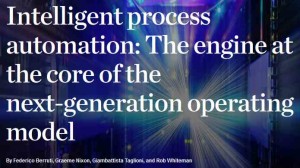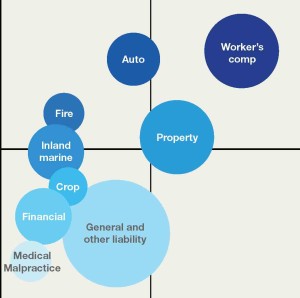Full intelligent process automation comprises five key technologies. Here’s how to use them to enhance productivity and efficiency, reduce operational risks, and improve customer experiences.
Since the financial crisis of 2007–09, many companies have applied lean management to improve cost efficiencies, customer satisfaction, and employee engagement simultaneously, and many programs have achieved substantial impact on all dimensions. Progress on digital, however, has been more uneven.
In the insurance sector, for example, an October 2016 FIS study found that 99.6 percent of insurers surveyed admitted they face obstacles in implementing digital innovation, while 80 percent recognize they need digital capabilities to meet business challenges. This difficulty has been compounded by the boom in “insurtech” investments in 2016—topping $3.5 billion in funding across 111 deals since 2015.
As macroeconomic conditions continue to put pressure on profit margins across sectors, cost productivity and unlocking new value are back at the top of the senior-management agenda. The question is, what else can be done?
That’s where intelligent process automation (IPA) comes in. We believe it will be a core part of companies’ next-generation operating models. Many companies across industries have been experimenting with IPA, with impressive results:
- Automation of 50 to 70 percent of tasks . . .
- . . . which has translated into 20 to 35 percent annual run-rate cost efficiencies . . .
- . . . and a reduction in straight-through process time of 50 to 60 percent . . .
- . . . with return on investments most often in triple-digit percentages.
New technologies that promise double-digit or even triple-digit same-year returns should rightfully be viewed with skepticism. But our experience shows that the promise of IPA is real if executives carefully consider and understand the drivers of opportunity and incorporate them effectively with the other approaches and capabilities that drive the next-generation operating model. (For more on these approaches and capabilities, please read “The next-generation operating model for the digital world.”)
What is intelligent process automation?
In essence, IPA “takes the robot out of the human.” At its core, IPA is an emerging set of new technologies that combines fundamental process redesign with robotic process automation and machine learning. It is a suite of business-process improvements and next-generation tools that assists the knowledge worker by removing repetitive, replicable, and routine tasks. And it can radically improve customer journeys by simplifying interactions and speeding up processes.
IPA mimics activities carried out by humans and, over time, learns to do them even better. Traditional levers of rule-based automation are augmented with decision-making capabilities thanks to advances in deep learning and cognitive technology. The promise of IPA is radically enhanced efficiency, increased worker performance, reduction of operational risks, and improved response times and customer journey experiences.
More: www.mckinsey.com/business-functions/digital-mckinsey/
By Federico Berruti, Graeme Nixon, Giambattista Taglioni, and Rob Whiteman

